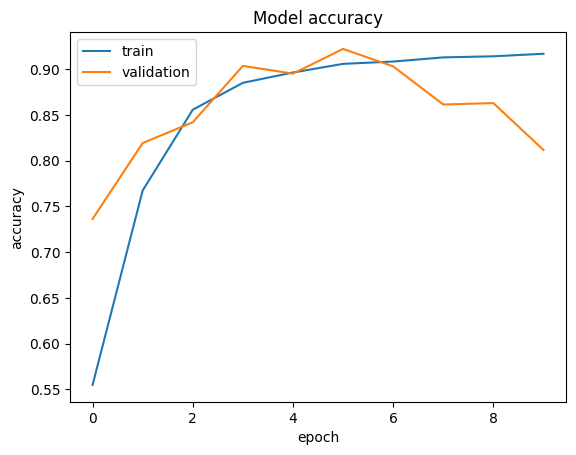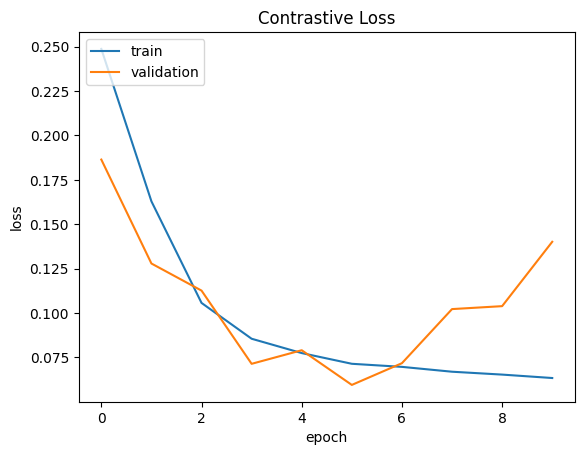无
使用 Siamese 网络和对比损失进行图像相似度估计
作者:Mehdi
创建日期 2021/05/06
最后修改日期 2022/09/10
描述:使用对比损失训练的 Siamese 网络进行相似度学习。
简介
Siamese 网络是指在两个或多个共享权重的网络之间共享权重的神经网络,每个网络都会生成其对应输入的嵌入向量。
在监督相似度学习中,网络随后被训练以最大化不同类别的输入的嵌入之间的对比度(距离),同时最小化相似类别输入的嵌入之间的距离,从而产生反映训练输入类别分割的嵌入空间。
设置
import random
import numpy as np
import keras
from keras import ops
import matplotlib.pyplot as plt
超参数
epochs = 10
batch_size = 16
margin = 1 # Margin for contrastive loss.
加载 MNIST 数据集
(x_train_val, y_train_val), (x_test, y_test) = keras.datasets.mnist.load_data()
# Change the data type to a floating point format
x_train_val = x_train_val.astype("float32")
x_test = x_test.astype("float32")
定义训练集和验证集
# Keep 50% of train_val in validation set
x_train, x_val = x_train_val[:30000], x_train_val[30000:]
y_train, y_val = y_train_val[:30000], y_train_val[30000:]
del x_train_val, y_train_val
创建图像对
我们将训练模型以区分不同类别的数字。例如,数字 0 需要与其余数字(1 到 9)区分开,数字 1 需要与 0 以及 2 到 9 区分开,以此类推。为了实现这一点,我们将从类别 A(例如,数字 0)中选择 N 张随机图像,并将它们与来自另一个类别 B(例如,数字 1)的 N 张随机图像配对。然后,我们可以为所有数字类别(直到数字 9)重复此过程。一旦我们将数字 0 与其他数字配对,就可以对剩余的数字(从 1 到 9)重复此过程。
def make_pairs(x, y):
"""Creates a tuple containing image pairs with corresponding label.
Arguments:
x: List containing images, each index in this list corresponds to one image.
y: List containing labels, each label with datatype of `int`.
Returns:
Tuple containing two numpy arrays as (pairs_of_samples, labels),
where pairs_of_samples' shape is (2len(x), 2,n_features_dims) and
labels are a binary array of shape (2len(x)).
"""
num_classes = max(y) + 1
digit_indices = [np.where(y == i)[0] for i in range(num_classes)]
pairs = []
labels = []
for idx1 in range(len(x)):
# add a matching example
x1 = x[idx1]
label1 = y[idx1]
idx2 = random.choice(digit_indices[label1])
x2 = x[idx2]
pairs += [[x1, x2]]
labels += [0]
# add a non-matching example
label2 = random.randint(0, num_classes - 1)
while label2 == label1:
label2 = random.randint(0, num_classes - 1)
idx2 = random.choice(digit_indices[label2])
x2 = x[idx2]
pairs += [[x1, x2]]
labels += [1]
return np.array(pairs), np.array(labels).astype("float32")
# make train pairs
pairs_train, labels_train = make_pairs(x_train, y_train)
# make validation pairs
pairs_val, labels_val = make_pairs(x_val, y_val)
# make test pairs
pairs_test, labels_test = make_pairs(x_test, y_test)
我们得到
pairs_train.shape = (60000, 2, 28, 28)
- 我们有 60,000 对
- 每对包含 2 张图像
- 每张图像的形状为
(28, 28)
拆分训练对
x_train_1 = pairs_train[:, 0] # x_train_1.shape is (60000, 28, 28)
x_train_2 = pairs_train[:, 1]
拆分验证对
x_val_1 = pairs_val[:, 0] # x_val_1.shape = (60000, 28, 28)
x_val_2 = pairs_val[:, 1]
拆分测试对
x_test_1 = pairs_test[:, 0] # x_test_1.shape = (20000, 28, 28)
x_test_2 = pairs_test[:, 1]
可视化图像对及其标签
def visualize(pairs, labels, to_show=6, num_col=3, predictions=None, test=False):
"""Creates a plot of pairs and labels, and prediction if it's test dataset.
Arguments:
pairs: Numpy Array, of pairs to visualize, having shape
(Number of pairs, 2, 28, 28).
to_show: Int, number of examples to visualize (default is 6)
`to_show` must be an integral multiple of `num_col`.
Otherwise it will be trimmed if it is greater than num_col,
and incremented if if it is less then num_col.
num_col: Int, number of images in one row - (default is 3)
For test and train respectively, it should not exceed 3 and 7.
predictions: Numpy Array of predictions with shape (to_show, 1) -
(default is None)
Must be passed when test=True.
test: Boolean telling whether the dataset being visualized is
train dataset or test dataset - (default False).
Returns:
None.
"""
# Define num_row
# If to_show % num_col != 0
# trim to_show,
# to trim to_show limit num_row to the point where
# to_show % num_col == 0
#
# If to_show//num_col == 0
# then it means num_col is greater then to_show
# increment to_show
# to increment to_show set num_row to 1
num_row = to_show // num_col if to_show // num_col != 0 else 1
# `to_show` must be an integral multiple of `num_col`
# we found num_row and we have num_col
# to increment or decrement to_show
# to make it integral multiple of `num_col`
# simply set it equal to num_row * num_col
to_show = num_row * num_col
# Plot the images
fig, axes = plt.subplots(num_row, num_col, figsize=(5, 5))
for i in range(to_show):
# If the number of rows is 1, the axes array is one-dimensional
if num_row == 1:
ax = axes[i % num_col]
else:
ax = axes[i // num_col, i % num_col]
ax.imshow(ops.concatenate([pairs[i][0], pairs[i][1]], axis=1), cmap="gray")
ax.set_axis_off()
if test:
ax.set_title("True: {} | Pred: {:.5f}".format(labels[i], predictions[i][0]))
else:
ax.set_title("Label: {}".format(labels[i]))
if test:
plt.tight_layout(rect=(0, 0, 1.9, 1.9), w_pad=0.0)
else:
plt.tight_layout(rect=(0, 0, 1.5, 1.5))
plt.show()
检查训练对
visualize(pairs_train[:-1], labels_train[:-1], to_show=4, num_col=4)

检查验证对
visualize(pairs_val[:-1], labels_val[:-1], to_show=4, num_col=4)

检查测试对
visualize(pairs_test[:-1], labels_test[:-1], to_show=4, num_col=4)

定义模型
有两个输入层,每个输入层都通向自己的网络,该网络产生嵌入。然后,一个 Lambda 层使用欧几里得距离将它们合并,并将合并后的输出馈送到最终网络。
# Provided two tensors t1 and t2
# Euclidean distance = sqrt(sum(square(t1-t2)))
def euclidean_distance(vects):
"""Find the Euclidean distance between two vectors.
Arguments:
vects: List containing two tensors of same length.
Returns:
Tensor containing euclidean distance
(as floating point value) between vectors.
"""
x, y = vects
sum_square = ops.sum(ops.square(x - y), axis=1, keepdims=True)
return ops.sqrt(ops.maximum(sum_square, keras.backend.epsilon()))
input = keras.layers.Input((28, 28, 1))
x = keras.layers.BatchNormalization()(input)
x = keras.layers.Conv2D(4, (5, 5), activation="tanh")(x)
x = keras.layers.AveragePooling2D(pool_size=(2, 2))(x)
x = keras.layers.Conv2D(16, (5, 5), activation="tanh")(x)
x = keras.layers.AveragePooling2D(pool_size=(2, 2))(x)
x = keras.layers.Flatten()(x)
x = keras.layers.BatchNormalization()(x)
x = keras.layers.Dense(10, activation="tanh")(x)
embedding_network = keras.Model(input, x)
input_1 = keras.layers.Input((28, 28, 1))
input_2 = keras.layers.Input((28, 28, 1))
# As mentioned above, Siamese Network share weights between
# tower networks (sister networks). To allow this, we will use
# same embedding network for both tower networks.
tower_1 = embedding_network(input_1)
tower_2 = embedding_network(input_2)
merge_layer = keras.layers.Lambda(euclidean_distance, output_shape=(1,))(
[tower_1, tower_2]
)
normal_layer = keras.layers.BatchNormalization()(merge_layer)
output_layer = keras.layers.Dense(1, activation="sigmoid")(normal_layer)
siamese = keras.Model(inputs=[input_1, input_2], outputs=output_layer)
定义对比损失
def loss(margin=1):
"""Provides 'contrastive_loss' an enclosing scope with variable 'margin'.
Arguments:
margin: Integer, defines the baseline for distance for which pairs
should be classified as dissimilar. - (default is 1).
Returns:
'contrastive_loss' function with data ('margin') attached.
"""
# Contrastive loss = mean( (1-true_value) * square(prediction) +
# true_value * square( max(margin-prediction, 0) ))
def contrastive_loss(y_true, y_pred):
"""Calculates the contrastive loss.
Arguments:
y_true: List of labels, each label is of type float32.
y_pred: List of predictions of same length as of y_true,
each label is of type float32.
Returns:
A tensor containing contrastive loss as floating point value.
"""
square_pred = ops.square(y_pred)
margin_square = ops.square(ops.maximum(margin - (y_pred), 0))
return ops.mean((1 - y_true) * square_pred + (y_true) * margin_square)
return contrastive_loss
使用对比损失编译模型
siamese.compile(loss=loss(margin=margin), optimizer="RMSprop", metrics=["accuracy"])
siamese.summary()
Model: "functional_3"
┏━━━━━━━━━━━━━━━━━━━━━┳━━━━━━━━━━━━━━━━━━━┳━━━━━━━━━┳━━━━━━━━━━━━━━━━━━━━━━┓ ┃ Layer (type) ┃ Output Shape ┃ Param # ┃ Connected to ┃ ┡━━━━━━━━━━━━━━━━━━━━━╇━━━━━━━━━━━━━━━━━━━╇━━━━━━━━━╇━━━━━━━━━━━━━━━━━━━━━━┩ │ input_layer_1 │ (None, 28, 28, 1) │ 0 │ - │ │ (InputLayer) │ │ │ │ ├─────────────────────┼───────────────────┼─────────┼──────────────────────┤ │ input_layer_2 │ (None, 28, 28, 1) │ 0 │ - │ │ (InputLayer) │ │ │ │ ├─────────────────────┼───────────────────┼─────────┼──────────────────────┤ │ functional_1 │ (None, 10) │ 5,318 │ input_layer_1[0][0], │ │ (Functional) │ │ │ input_layer_2[0][0] │ ├─────────────────────┼───────────────────┼─────────┼──────────────────────┤ │ lambda (Lambda) │ (None, 1) │ 0 │ functional_1[0][0], │ │ │ │ │ functional_1[1][0] │ ├─────────────────────┼───────────────────┼─────────┼──────────────────────┤ │ batch_normalizatio… │ (None, 1) │ 4 │ lambda[0][0] │ │ (BatchNormalizatio… │ │ │ │ ├─────────────────────┼───────────────────┼─────────┼──────────────────────┤ │ dense_1 (Dense) │ (None, 1) │ 2 │ batch_normalization… │ └─────────────────────┴───────────────────┴─────────┴──────────────────────┘
Total params: 5,324 (20.80 KB)
Trainable params: 4,808 (18.78 KB)
Non-trainable params: 516 (2.02 KB)
训练模型
history = siamese.fit(
[x_train_1, x_train_2],
labels_train,
validation_data=([x_val_1, x_val_2], labels_val),
batch_size=batch_size,
epochs=epochs,
)
Epoch 1/10
3750/3750 ━━━━━━━━━━━━━━━━━━━━ 16s 3ms/step - accuracy: 0.4802 - loss: 0.2768 - val_accuracy: 0.7363 - val_loss: 0.1864
Epoch 2/10
3750/3750 ━━━━━━━━━━━━━━━━━━━━ 11s 3ms/step - accuracy: 0.7368 - loss: 0.1827 - val_accuracy: 0.8193 - val_loss: 0.1279
Epoch 3/10
3750/3750 ━━━━━━━━━━━━━━━━━━━━ 11s 3ms/step - accuracy: 0.8480 - loss: 0.1117 - val_accuracy: 0.8420 - val_loss: 0.1126
Epoch 4/10
3750/3750 ━━━━━━━━━━━━━━━━━━━━ 11s 3ms/step - accuracy: 0.8834 - loss: 0.0871 - val_accuracy: 0.9037 - val_loss: 0.0714
Epoch 5/10
3750/3750 ━━━━━━━━━━━━━━━━━━━━ 11s 3ms/step - accuracy: 0.8932 - loss: 0.0797 - val_accuracy: 0.8952 - val_loss: 0.0791
Epoch 6/10
3750/3750 ━━━━━━━━━━━━━━━━━━━━ 11s 3ms/step - accuracy: 0.9047 - loss: 0.0721 - val_accuracy: 0.9223 - val_loss: 0.0595
Epoch 7/10
3750/3750 ━━━━━━━━━━━━━━━━━━━━ 11s 3ms/step - accuracy: 0.9070 - loss: 0.0704 - val_accuracy: 0.9032 - val_loss: 0.0718
Epoch 8/10
3750/3750 ━━━━━━━━━━━━━━━━━━━━ 11s 3ms/step - accuracy: 0.9122 - loss: 0.0680 - val_accuracy: 0.8615 - val_loss: 0.1022
Epoch 9/10
3750/3750 ━━━━━━━━━━━━━━━━━━━━ 11s 3ms/step - accuracy: 0.9132 - loss: 0.0664 - val_accuracy: 0.8630 - val_loss: 0.1039
Epoch 10/10
3750/3750 ━━━━━━━━━━━━━━━━━━━━ 11s 3ms/step - accuracy: 0.9187 - loss: 0.0621 - val_accuracy: 0.8117 - val_loss: 0.1401
可视化结果
def plt_metric(history, metric, title, has_valid=True):
"""Plots the given 'metric' from 'history'.
Arguments:
history: history attribute of History object returned from Model.fit.
metric: Metric to plot, a string value present as key in 'history'.
title: A string to be used as title of plot.
has_valid: Boolean, true if valid data was passed to Model.fit else false.
Returns:
None.
"""
plt.plot(history[metric])
if has_valid:
plt.plot(history["val_" + metric])
plt.legend(["train", "validation"], loc="upper left")
plt.title(title)
plt.ylabel(metric)
plt.xlabel("epoch")
plt.show()
# Plot the accuracy
plt_metric(history=history.history, metric="accuracy", title="Model accuracy")
# Plot the contrastive loss
plt_metric(history=history.history, metric="loss", title="Contrastive Loss")


评估模型
results = siamese.evaluate([x_test_1, x_test_2], labels_test)
print("test loss, test acc:", results)
625/625 ━━━━━━━━━━━━━━━━━━━━ 1s 1ms/step - accuracy: 0.8068 - loss: 0.1439
test loss, test acc: [0.13836927711963654, 0.8143500089645386]
可视化预测结果
predictions = siamese.predict([x_test_1, x_test_2])
visualize(pairs_test, labels_test, to_show=3, predictions=predictions, test=True)
625/625 ━━━━━━━━━━━━━━━━━━━━ 1s 619us/step
